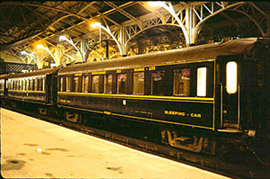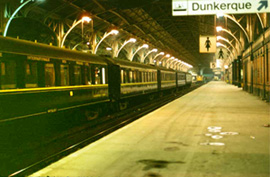| From November 1 a Third Class Kitchen Pullman car (one of either No. 17 or No. 19) was included in the make-up of the English leg to provide a full catering service between Victoria and Dover for the sleeping car clients. Later a Third Class Pullman (one of either No. 20 or No. 21) was added so that the seating car passengers could take nourishment. After the war the Pullmans made way for two BR Restaurant Buffet cars. The Night Ferry was famous for its “English breakfeast” served in the Pullmans.
The wasteful use of two Pullmans was the result of the British authorities refusing to carry out customs inspection and passport control on the train and also requiring strict segregation of sleeping and walking passengers, the former undergoing customs inspection at Victoria. Departing passengers had to be at Victoria at least half an hour before departure time and late comers were indeed sometimes turned away as the regulations threatened. On one occasion in 1939 Lord Chief Justice Hewitt arrived in London on the Night Ferry and was escorted through Customs by Donald White, Cook’s senior Interpreter who was a well-known figure. The Custom officer had been examining suitcases left and right whereat Donald White hissed in his ear : “That is the Lord Chief Justice”. His Lordship looked him sternly in the eye and remarked severely : “Do not think that will save you, when you come before me”. |
The Voiture Restaurant was attached to the seating coaches next to the sleeping-cars. No 2700 was used at first, built in 1926 for the President’s train. Its 42 armchairs sufficed when only 3 or 4 sleepers ran in the Night ferry, but after 1952 a standard 56-eater was used, including 2827,and later 3631.
You could still have your coffee and croissants in bed, served by the sleeper’s conductor , but most passengers rose for Le Meat-Breakfast, as Wagons-Lits called it all over Europe. Oeufs sur le plat with ham arrived in an almost red-hot metal platter straight off the coal-fired range, cereals and fruit juices were available and baskets of hot toast, croissants, brioches, and fresh fruit were brought around. While you were breakfasting, the sleeping car conductors made down the beds.
Dinner in the evening was poorly patronized , as the French customs officers and police carried out their duties between Paris and Creil, and only after they got off there could London-bound Night Ferry passengers repair to the dining car. So the Serveur would follow the officers down the corridor with bottles of spirits, beneficial to anyone with excess currency to dispose of.
|





